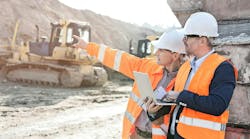A job hazard analysis (JHA) is completed prior to the start of any construction job where there is potential for injury or accident. Larger general contractors have made these a common requirement before the start of work on their projects. This is a way for both subcontractors and general contractors to collaborate on safety management. A JHA helps determine the risk of the work being completed on the site. In simple terms, it is a tool to reduce the chance of a loss from occurring.
When a company is tasked with completing a JHA, it is important to note the complete scope of work that they will be conducting while on site. This starts from the moment they step foot on the job all the way until they walk back out the door. When looking at the larger scale of the project, you would be surprised at how many different rudimentary tasks could be considered a potential risk or “hazard.”
This could be considered a best practice in the industry even if a general contractor does not require one to be filled out. A company could make it a daily part of their safety operating plan for each job they start.
To simplify, let’s break this down into five simple steps.
Understand the JHA format or develop your own company JHA form
This is the first question when working on a JHA: Is the general contractor requiring that each company on site use its specific JHA form, or can a company use its own template? This first step is important, as many smaller companies may not have their own JHA form. The easy solution is to search for one on the internet or feel free to refer to OSHA's. Companies could also ask the general contractor to provide a template as well; they would be happy to assist.
Review the scope of work being completed
Work with your company’s project management team, foreman, and/or field staff to fully understand the work that is being completed. Take into consideration any major health and safety hazards that will be present during the work process.
Understand the potential hazards, risks, and controls
This is your opportunity to expand your knowledge of the steps taken to complete tasks, understand the potential hazards associated with completing said tasks, and determine the controls or process changes/improvements that can be made to reduce potential risks.
Fill in the correct information pertaining to each line item on the JHA
The common format of a JHA is usually broken down into three different categories: job steps, potential hazards, and recommended controls. It is important to be thorough in each of these areas. General contractors want to see these areas explaining your company processes and how the company plans to control the potential hazards associated with the tasks being completed.
Review the JHA and improve the workflow
Every job that is completed is different and poses a new set of challenges. It is important to be cognizant of these changes, which will help workers understand all potential hazards and best practices for control moving forward.
Investigation and incident reviews
JHA’s should be utilized by field staff to understand potential risks involved with the tasks that each worker will complete. This helps give clear instruction to all workers on how to complete the task and how to do so without injury or incident. If they are following the JHA, it should be a guide for them on safe work. A JHA will list the hazards, controls, personal protective equipment, etc.
JHAs should be utilized when completing a work-related accident investigation regarding an injury or incident. They serve as a template to see where things went awry, and the JHA itself should be updated if a risk was not identified previously.
In summary, a JHA is a safety tool used to help bring project safety, office management, and field staff together to review the potential risk.




